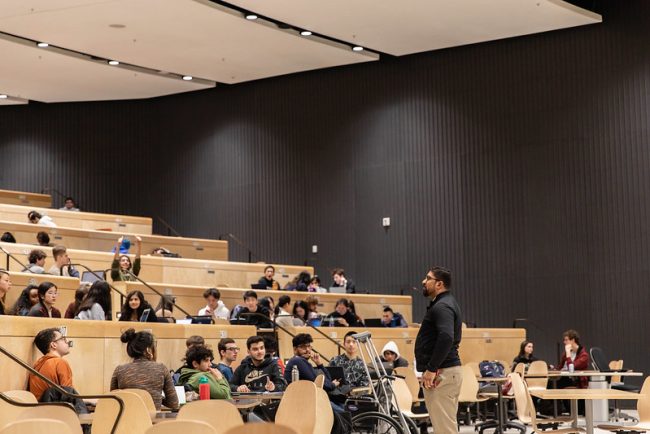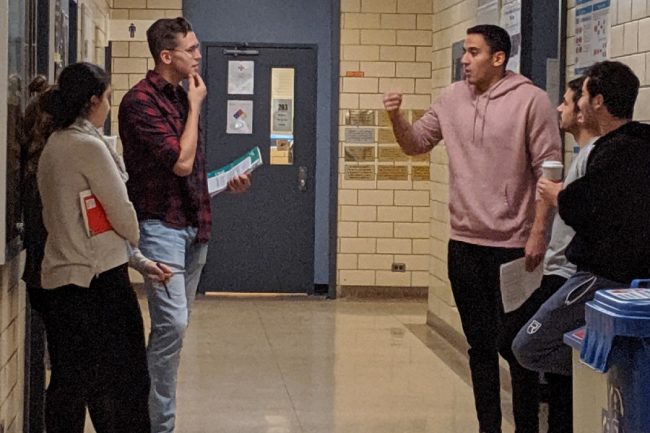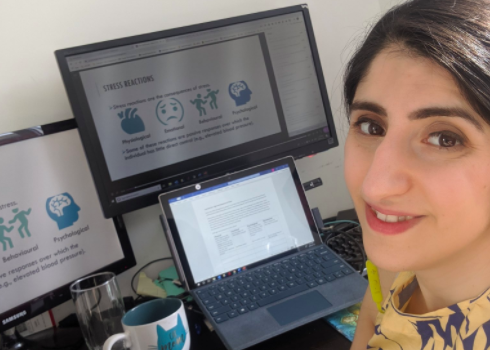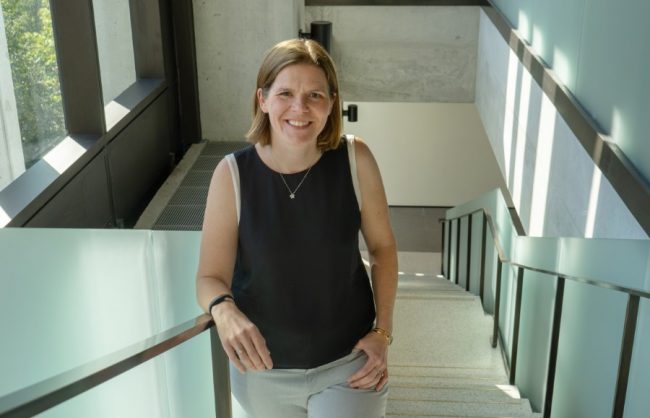During a typical academic year, Professor Chirag Variawa’s (ISTEP) pre-lecture ritual involved taking a walk and listening to music before making his way into the Lee & Margaret Lau Auditorium, a large collaborative space in the Myhal Centre that seats nearly 500 people. Inside, the room would be filled to near-capacity with first-year engineering students.
“I’d fire up the laptop, the screen turns on, and the room goes quiet,” says Variawa. “Students are looking ahead at me, at the screen, and it’s time to teach.”

This fall, as the U of T Engineering community gets set to begin classes remotely, Variawa’s prep — and his peers’ — is looking much different. Professors have used the summer to reimagine their course delivery and reassess their teaching approaches.
Variawa is teaching APS 100: Orientation to Engineering this fall, a course taken by more than 1,000 first-year engineering students in a variety of different disciplines.
“It’s difficult to lecture off into the ether to 1,000 students,” says Variawa. “We’re so used to looking around the classroom to gauge their interest in these concepts.”
To keep students immersed in topics such as engineering ethics, academic integrity, as well as equity, diversity and inclusion, he’s taking advantage of some high-tech equipment to give his lectures some polish and reflect his creativity.
At home, Variawa has set up a green-screen background, a professional microphone and camera, as well as three monitors. The background allows for him to appear alongside his slides as he lectures, and even to make cameos in videos he’ll be showing the class.

The course’s Teaching Assistants (TA) will also facilitate virtual breakout sessions, an opportunity for active learning, discussions, “and to build rapport, a sense of community, between students and their instructors,” says Variawa.
While Variawa has found digital solutions to present his lectures, Professor Marianne Touchie (CivMin) is redefining what it means to “chalk and talk” for her course, CIV 375/575: Building Science.
Touchie’s classes will be delivered using light boards in place of chalk boards, as well as a mix of tablet screen capture, green-screen lectures, motion graphics and interactive activities. She is also hoping to create a virtual three-dimensional house for students to explore as part of their labs.
“It would be so neat to teach students how components of a building fit together by enabling them to see into the walls to closely study the materials,” she explains.
Touchie acknowledges she’s had a head start: she and Professor Kim Pressnail (CivMin) began creating filmed lectures in 2018 to eventually support a flipped-classroom experience. As a result, Building Science already has more than 100 lecture videos ready to go.
“Our current situation gives us a chance to iterate how we’re using with these video resources,” says Touchie. Over the summer, she and Pressnail have redesigned the course framework with new modes of engagement and assessment. Touchie says the emphasis will be on fostering discussions and collaborative group projects, allowing students to build relationships with their peers.
Undergraduate and graduate students are usually huddled together in groups or sitting face-to-face in APS 500: Negotiation in an Engineering Context, taught by Professor Elham Marzi (ISTEP). The course explores small and big negotiation scenarios in industry. The grand finale is a United Nations-style, multi-party, multi-stakeholder roundtable negotiation meeting.

“Students get really into it — they debate each other, caucus in the hallway, build coalitions, and they pound their fists on the table,” says Marzi. “For this term, I had to think, how do we get students to be as engaged and be able to express themselves in the same way?”
Marzi says she isn’t necessarily rewriting the script this fall term — negotiations lectures will be done using the software package BB Collaborate instead of in-person — however her classes will still have many opportunities for students to practice their newly honed negotiation skills.
When students are given role-playing scenarios to practice, they will be paired and grouped differently each time. The virtual spaces will also allow students to record their negotiations to better assess themselves and give feedback to partners.

“That feedback is going to be immensely valuable and unique,” adds Marzi. “Up until now, we’d rarely been able capture a play-by-play of a negotiation.”
For Professor Natalie Enright Jerger (ECE), the focus this summer wasn’t on how she’d adapt her course online — she’ll use a combination of pre-recorded lectures and live demonstrations — but rather a reassessment of her teaching philosophy.
“The adjustment to working and learning from home was tough for everybody. I felt a lot of anxiety about how to balance work and taking care of my daughter,” says Enright Jerger. “I’m looking at this course through the lens of compassion and empathy — I’m trying to put myself in my students’ shoes. If I’m feeling this unsure, what must they be feeling? How can I be there to support them?”

Enright Jerger has filmed a welcome video for ECE 253: Digital and Computer Systems, where she not only introduces the course, but shares details about herself and the challenges she has faced since the COVID-19 pandemic.
“I also address what I perceive as challenges my students could be facing, whether they’re feeling isolated, or are struggling with sharing their space, or are providing care for loved ones,” says Enright Jerger, whose TAs will also be making similar videos. “Getting to know each other is going to be such a challenge this term. I want them to know I’m open to hearing about their challenges.”
In MIE 303/311: Mechanical and Thermal Energy Conversion, a major component in students’ learning experience is getting to observe the internationally unique, real-life heat engines in the Energy Lab, located in the Mechanical Engineering Building.
“The switch to remote delivery gives us an opportunity to improve access for all students.” — Professor Aimy Bazylak
To replicate this online, Professor Aimy Bazylak (MIE) worked with Tomas Bernreiter, laboratory engineer and manager, and TA Raymond Guan (MIE MASc candidate) to film high-resolution videos to showcase up-close details of the Energy Lab’s engines and turbines. The videos feature Jason Chan (MIE MASc candidate) and other TAs leading students through experiments and a detailed look of the various working pieces of the engines.
“The switch to remote delivery gives us an opportunity to improve access for all students. In a normal setting, we have groups of five to 15 with each engine, and there will inevitably be some who get a better view and enhanced engagement with the lab,” explains Bazylak. “These videos will help facilitate smaller-group interactions between students and TAs and improve access for all students, as we strive to deliver the best possible lab experience.”

Bazylak says that pivot from an in-person experience to an online experience has allowed her to reflect on her role as an educator, as well as the tools and approach she’ll use to effectively teach, even after the pandemic is over.
“This pandemic has forced me to re-examine how I can best add value to the learning experience — it’s not just about delivering the information and giving students the opportunity to learn,” says Bazylak.
“Key measures of success for me will be the engagement I can achieve with my students and how much they value their time in my lectures, tutorials and labs. By teaching remotely, I can engage with students in new ways that will bring value to my virtual class now, and my literal classroom down the line.”
-This story was originally published on the University of Toronto’s Faculty of Applied Science and Engineering News Site on August 27, 2020 by Liz Do